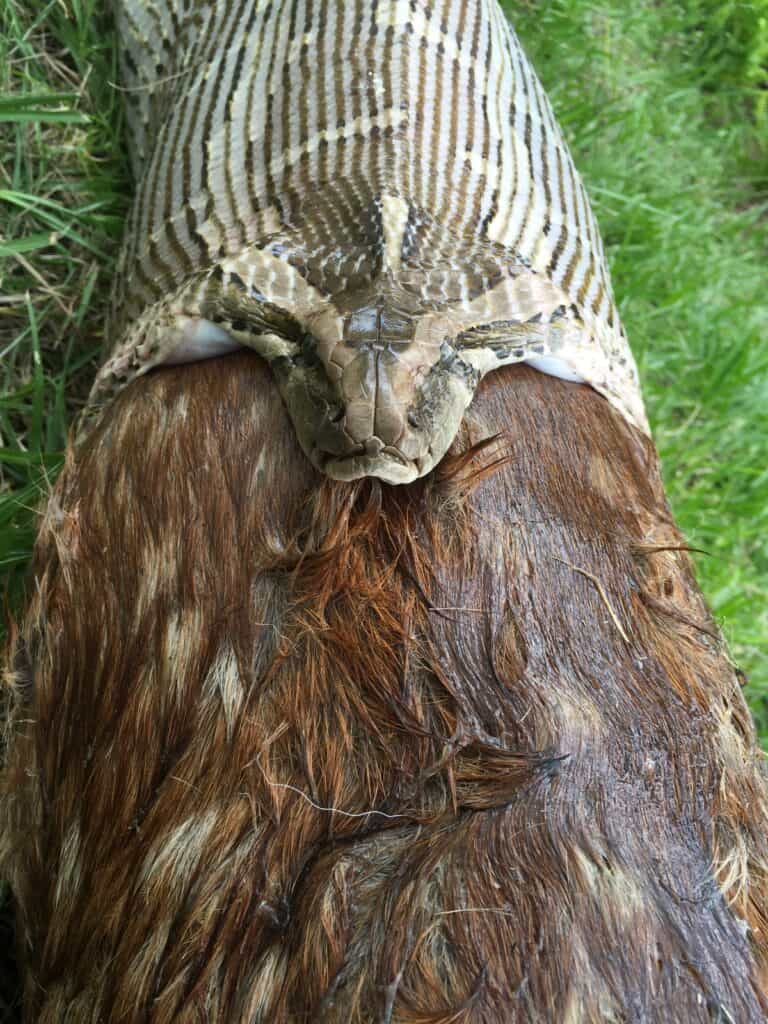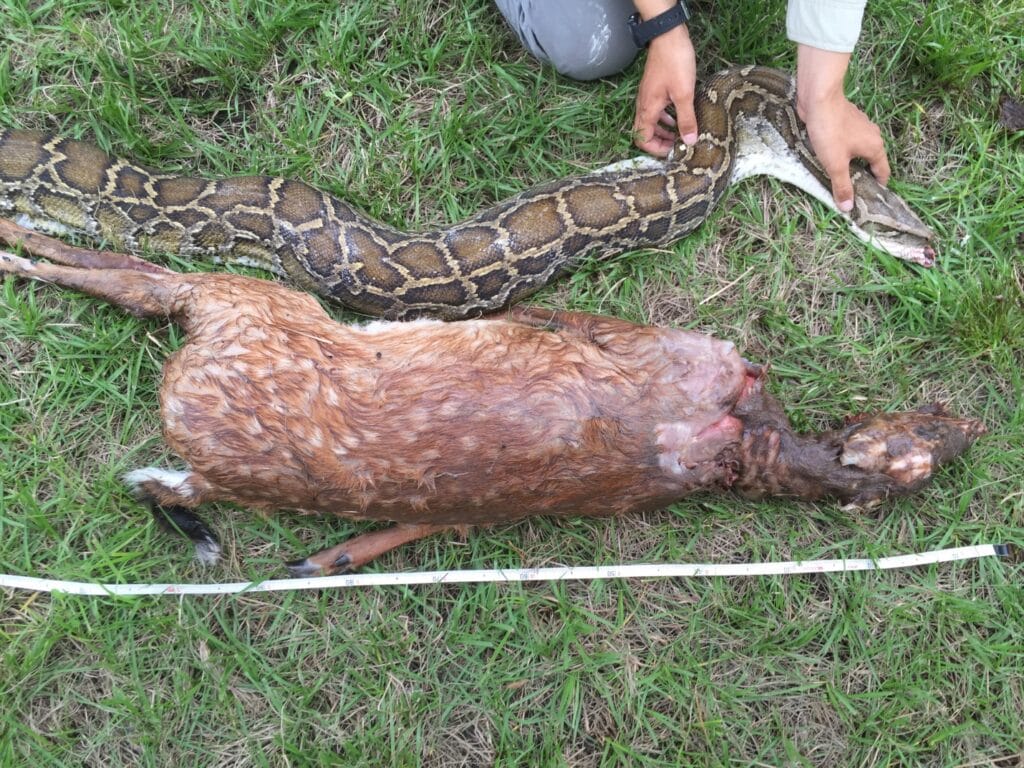Every Valentine’s Day, scientists follow invasive snakes to breeding piles, a strategy that’s helped remove over 20 tons from the Everglades
The python research team bends over a table beneath bright fluorescent lights, carefully slicing open the belly of a Burmese python hatchling. A veterinarian inserts a pill-sized tracking transmitter into the tissue and carefully sews it back up. The procedure, precise and practiced, is part of a long-term effort to study the survival and development of these invasive predators from their earliest days to better understand population dynamics.
In the lab’s cooler room and freezers, large adult pythons—many over 100 pounds—fill every shelf in the cooler, coiled up on themselves in gray bins ready to be necropsied and aid in knowledge acquisition. Each snake collected by the Conservancy of Southwest Florida is destined to yield data for researchers across the region, maximizing the value of the removal efforts and providing a comprehensive insight into invasion dynamics. Nearby sits a large -80-degree chest freezer filled with rows of meticulously labeled vials, a genetic archive, fragments of DNA collected over time—a treasure trove of information aimed at building a clearer picture of python invasion dynamics.

“We love snakes. We have tremendous respect for them,” said Ian Bartoszek, Environmental Science Project Manager and founder of the program. “We humanely remove invasive pythons, but we also get as much science out of these animals as possible.”
Since launching its research and removal program in 2013, the Conservancy has removed more than 20 tons of Burmese pythons (Python bivittatus), equivalent to over 40,000 pounds of apex predator, and prevented over 20,000 python eggs from hatching across both public and private lands from Naples to the western Everglades. The Conservancy removes them from the ecosystem as part of its stated commitment of “protecting our water, land, wildlife and future.”

The core of this program’s success is its use of radio telemetry and aerial scouting. But it certainly isn’t powered just by legwork. Rather, a team of 40 “scout snakes,” radio-tagged male Burmese pythons deployed during the breeding season to locate reproductive females, does the slither-work. These males are carefully tracked and relocated weekly, leading researchers to reproductive females during the breeding season. On occasion, these scout males will lead researchers to other males in large, writhing breeding aggregations. These proven males that have demonstrated they can find female snakes are then incorporated into the program, expanding the unwitting workforce.
It’s this search for a mate that makes the removal program so successful. Removing breeding females is important because the team is reducing their long-term impact and the impact of their potential progeny. The program began with just four snakes and one of them, Luther, holds the distinction of being the longest continuously tracked Burmese python in the world, having led researchers to females for more than a decade.
“We have a small window of time, and we try to maximize it,” said Bartoszek, referring to the breeding season that runs from December through April, peaking in February. “Valentine’s Day, you can usually find us on a pile of pythons.”
Diet and damage
The team does not limit itself to accessible snakes. Instead, they go where the snakes go, often into remote areas of the Everglades and across public and private land, all to suppress the local population and carry the snakes out on their backs and by boat where possible.
The collaborative science they’ve published to date includes a detailed look into python ecology. Stomach content analysis with research partners at the University of Florida has revealed the consumption of over 85 native species.

In some cases, prey items have exceeded 100% of the snake’s body mass. One python the team and its collaborators found weighed 31.5 pounds and consumed a 35-pound white-tailed deer (Odocoileus virginianus) fawn, defying previous understanding of mouth size limitations. Understanding the size limits of prey that predators can eat helps researchers predict the impact that this invasive snake has on native wildlife.
“Imagine what 42,000 pounds of snake represent in pounds of native wildlife consumed. These generalist apex predators are causing cascading effects through the Everglades food web.” Bartoszek said, emphasizing the impact of the species as well as the benefit of removal efforts to the ecosystem.
Despite the success, Bartoszek acknowledged that managers may never fully eradicate the Burmese python. However, there are encouraging signs. The team is encountering fewer reproductive females and smaller individuals in areas with long-term management efforts, possibly indicating that local suppression is working.
“We need to follow the science on this issue.” Bartoszek said.





